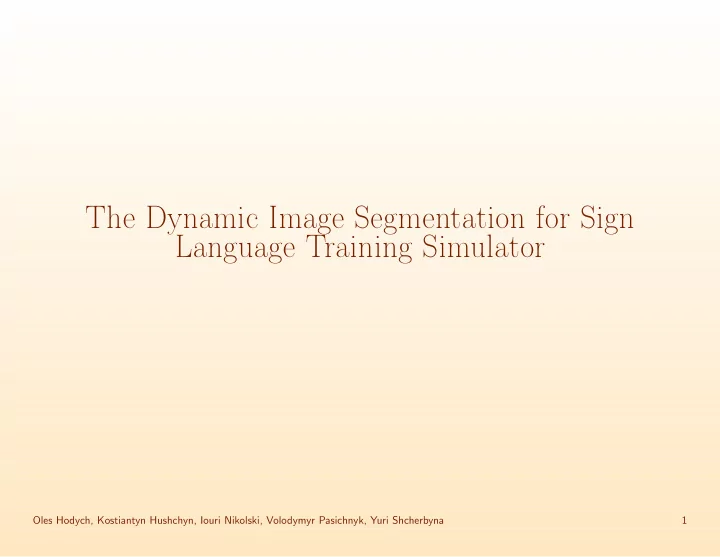

The Dynamic Image Segmentation for Sign Language Training Simulator Oles Hodych, Kostiantyn Hushchyn, Iouri Nikolski, Volodymyr Pasichnyk, Yuri Shcherbyna 1
Gesture (a) Start of the gesture (b) Intermediate frame (c) Intermediate frame (d) Final frame Figure 1: Gesture “What for” Oles Hodych, Kostiantyn Hushchyn, Iouri Nikolski, Volodymyr Pasichnyk, Yuri Shcherbyna 2
Dactyl (a) Starting dactyl (b) Final dactyl Figure 2: Dactyls describing gesture “What for” Oles Hodych, Kostiantyn Hushchyn, Iouri Nikolski, Volodymyr Pasichnyk, Yuri Shcherbyna 3
Dactyl Matching Figure 3: Recognition of Fingertips Oles Hodych, Kostiantyn Hushchyn, Iouri Nikolski, Volodymyr Pasichnyk, Yuri Shcherbyna 4
Colour Space in Image Clustering with SOM (a) Original (b) RGB (c) HSL (d) CIELab Figure 4: Clustering of an image represented in different colour spaces Oles Hodych, Kostiantyn Hushchyn, Iouri Nikolski, Volodymyr Pasichnyk, Yuri Shcherbyna 5
Training Data Composition ( L 1 1 , a 1 1 , b 1 1 ) T ( L 1 2 , a 1 2 , b 1 2 ) T ( L 1 3 , a 1 3 , b 1 3 ) T ( L 1 4 , a 1 4 , b 1 4 ) T ( L 2 1 , a 2 1 , b 2 1 ) T ( L 2 2 , a 2 2 , b 2 2 ) T ( L 2 3 , a 2 3 , b 2 3 ) T ( L 2 4 , a 2 4 , b 2 4 ) T A = ( L 3 1 , a 3 1 , b 3 1 ) T ( L 3 2 , a 3 2 , b 3 2 ) T ( L 3 3 , a 3 3 , b 3 3 ) T ( L 3 4 , a 3 4 , b 3 4 ) T ( L 4 1 , a 4 1 , b 4 1 ) T ( L 4 2 , a 4 2 , b 4 2 ) T ( L 4 3 , a 4 3 , b 4 3 ) T ( L 4 4 , a 4 4 , b 4 4 ) T ( L 1 1 , a 1 1 , b 1 1 ) T ( L 1 2 , a 1 2 , b 1 2 ) T S 1 = 1 ) T 2 ) T ( L 2 1 , a 2 1 , b 2 ( L 2 2 , a 2 2 , b 2 Oles Hodych, Kostiantyn Hushchyn, Iouri Nikolski, Volodymyr Pasichnyk, Yuri Shcherbyna 6
Cluster Interpretation • Image pixels represented by topologically close neurons should be- long to the same cluster and therefore segment. • The colour or marker used for a segment representation is irrelevant as long as each segment is associated with a different one. R j ← x j + y j × λ ; G j ← x j + y j × λ ; B j ← x j + y j × λ ; (1) Oles Hodych, Kostiantyn Hushchyn, Iouri Nikolski, Volodymyr Pasichnyk, Yuri Shcherbyna 7
Application Results (a) Frame 25 original (b) Frame 25 segmented (c) Frame 35 original (d) Frame 35 segmented Figure 5: Frames 25 and 35 Oles Hodych, Kostiantyn Hushchyn, Iouri Nikolski, Volodymyr Pasichnyk, Yuri Shcherbyna 8
Application Results (a) Frame 45 original (b) Frame 45 segmented (c) Frame 65 original (d) Frame 65 segmented Figure 6: Frames 45 and 65 Oles Hodych, Kostiantyn Hushchyn, Iouri Nikolski, Volodymyr Pasichnyk, Yuri Shcherbyna 9
Other Applications (a) Original (b) Segmented (c) Original (d) Segmented Figure 7: Cloth Segmentation for Image Search Oles Hodych, Kostiantyn Hushchyn, Iouri Nikolski, Volodymyr Pasichnyk, Yuri Shcherbyna 10
Alternative Approach (a) Sample 1 (b) Sample 2 Figure 8: Cloth Segmentation for Image Search Oles Hodych, Kostiantyn Hushchyn, Iouri Nikolski, Volodymyr Pasichnyk, Yuri Shcherbyna 11
Recommend
More recommend